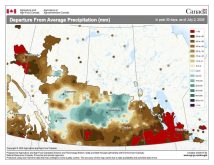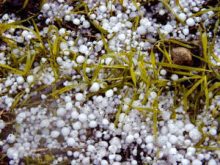Severe weather systems containing strong winds, tornadoes, heavy rains and hail passed through several areas of Manitoba.
Field and forage crops, as well shelterbelts and farm infrastructure, were impacted by the storms. Crop damage, including lodging and stalk breakage, ranges from light to severe. Assessments are continuing.
The warmer temperatures benefitted all crops, particularly the warm season crops including corn, soybeans and sunflowers.
Disease pressure is being monitored, with reports of blackleg lesions and sclerotinia in canola, bacterial leaf blight in soybeans and fusarium head blight in winter and spring wheat.
Read Also

Gene editing up a better canola crop: FEATURE
Gene editing techniques and maize genetic material may be the seed for more robust and stress tolerant canola plants. Canadian research is trying to make it happen.
First and second cut haying operations continue across Manitoba.
Southwest Region
Scattered rainfall occurred throughout the Southwest Region last week; localized thunderstorms produced heavy precipitation and hail. Forrest and Brandon area received 75 to 80 mm while Hamiota, Shoal Lake, Deloraine, Virden and Melita received 5 to 20 mm. Strong winds across the region also resulted in some crop lodging. There was tornado damage south of Hartney. Symptoms of excess moisture are evident in crops. Producers continue to make hail claims.
Approximately 80 to 90 per cent of winter cereal acres are close to maturity. Preharvest applications are being made. Fusarium head blight can be found easily in most fields but at low levels. The extent of lodging within fields is variable. Spring cereals are in very good shape. About 70 per cent of the fields are at soft to hard dough stage, with the remaining 30 per cent in the milk stage. There are some reports of cereal aphids in spring wheat. In canola, 30 per cent of the acres have completed flowering; most advanced crops are in the southern areas of the region. Later seeded canola acres are advancing very quickly with the warm and humid weather conditions. Pod formation is well underway without any issues. Sclerotinia and blackleg are starting to appear in mostly lodged areas of the field.
Flax fields are at 70 per cent pod formation stage and done flowering. Peas and lentils are showing disease in majority of fields. High moisture conditions are creating more difficulties for these two crops. Most peas are now at pod filling stage. Most soybean fields are flowering and some have started pod formation. Sunflowers range in development from bud formation to early flowering stage. Corn is progressing well with no major problems.
Generally, fungicide applications are completed across the Southwest Region. enerally, fungicide applications are completed across the Southwest Region.
First cut hay is complete and there is strong growth for second cut with the moisture and warm weather conditions. Some producers are choosing to ensile alfalfa to retain feed quality and to try to have crop harvested prior to rainfall. Pastures are rated in good condition due adequate moisture. Dugouts are 100 per cent full.
Northwest Region
Thunderstorm activity throughout most of the Northwest Region over the past week resulted in variable rainfall amounts. Reported rainfall amounts ranged from 10 to 24 mm in the Roblin area to 10 mm in The Pas and 25 to more than 35 mm in the Swan Valley. Some crop lodging due to rain and/or wind is evident throughout the entire region. Soil moisture conditions are variable, ranging from adequate in most areas to excessive in some parts of the Swan Valley, The Pas and south of Ste Rose. Crops in these areas are showing the effects of excessive moisture with yellowing and crop loss in low lying areas.
In general, most field crops throughout the region continue to advance nicely and are in relatively good condition. With regards to crop stage of growth, fall rye and winter wheat crops are in the dough stage. The perennial ryegrass harvest has begun. Most spring wheat is in the milk to dough stage with some color change. Canola continues to develop rapidly. Approximately 40 per cent percent of the canola is flowering and 60 per cent is podded. Field peas are also advancing quickly. Reports indicate that about 25 per cent of the field peas are blooming and 75 per cent are podded. The majority of the soybeans are in the R1 to R3 stage of growth.
Aster yellows are reported in canola in the Swan Valley; low levels are reported to date. Due to wet field conditions at The Pas, some aerial fungicide applications have been made. Reports of disease and insect activity are minimal but producers continue to monitor crops closely for the presence of any pest activity.
Significant and frequent rains still pose challenges to first cut haying operations. Cereals for silage or greenfeed will be cut soon. Pastures remain in good to excellent condition.
Central Region
Temperatures were average to above average in the Central Region and humidex levels were uncomfortably high. A major storm system affected areas of the region, with strong winds causing significant damage to crops, buildings, grain bins and fence lines; power outages were also reported. Significant lodging and stalk breakage is seen in areas impacted by the high winds. Areas affected included Somerset, St. Leon, Manitou, and north of St.Claude, Haywood and Elm Creek. A tornado caused damage in Long Plains First Nation and Southport. Large hail also impacted a number of fields; many of which had already been impacted by hail earlier in the season.
Rainfall accumulations varied over the past week, but much of the region received 25 mm and more; accumulations as high as 150 mm were reported south of Morden. Standing water remains a concern. The more advanced crops are handling the higher rainfall amounts, although stand thinning is evident in those crops as well. Standing water is evident in low spots of fields.
Cereals continue to advance. Fall rye and winter wheat are progressing well. Fields are in good to excellent condition as they continue to mature. Fusarium head blight is evident in winter wheat. Some winter wheat was harvested late last week; no yield reports to date. Swathing has begun in some fields. Preharvest applications continue to be made and the crop will be harvested over the next couple of weeks. Fall rye harvest is expected to begin shortly, as conditions allow.
Heading stage is reached in all spring cereals. Lodging is reported in some of the earliest seeded fields; a result of high winds and thunderstorm activity. Some plants are starting to die back due to root rots; premature ripening is noticeable in scattered plants and adjacent to drains and low areas. Some perennial ryegrass is being cut. The later seeded canola is growing rapidly, and most is in full flower. Flowering is complete and pods are formed in the early seeded fields. Swathing is likely to start in three weeks. Some fields are doing surprisingly well, despite conditions. Lodging is evident, due to high winds and soft field conditions.
Corn is growing rapidly and has reached silking stage. Soybeans continue to flower and pod. Many fields range from R2 to R4 stage. Bacterial blight is evident in a number of fields. Flowering in peas continues and podding has begun. Stands look good where excess moisture is not an issue. Plants in low areas are starting to die back; more losses are expected due to poor/damaged roots. Edible beans are flowering, and fungicide applications continue. Flax continues to flower and boll formation has begun. Sunflowers have begun to flower and are being monitored for head insects.
The majority of fungicide applications in cereals and canola are now complete. Some spraying for aphids in canaryseed has taken place.
Insect monitoring continues for insects including lygus, aphids and grasshoppers, with numbers low to date. Beneficial predators are evident in good numbers in most fields.
Good growth of forages continues, but continuing wet conditions leave producers struggling with hay harvest. Some are ensiling to deal with the adverse conditions. Some greenfeed and cereals are being cut for silage. With late cutting of forages due to the wet weather conditions, nutritional value of forages is lower. Some second cut has been done. There is abundant grass growth in pastures. Livestock water supply is adequate.
Eastern Region
Rainfall accumulations in the Eastern Region varied from 10 mm to over 50 mm; higher precipitation levels occurred in northern and southern districts. Last week’s weather included more sunshine and heat which benefitted warm season crop development. However, those conditions also resulted in instances of fast moving thunderstorms, isolated heavy rainfall events and severe weather. Some instances of lodging and hail damage in crops during these storms were noted, as was some property damage. Generally, fields did become more accessible to ground traffic than in past weeks but humidity levels remained high and persistent rainfall events meant that progress in field drying was slower than desired. Loss of yield potential due to excess moisture continues to occur across the Eastern Region and some standing water in fields is evident, especially in northern and southern districts.
Winter cereals range from the soft to firm dough growth stages to almost mature in some instances. Pre-harvest applications were on-going last week where weather and appropriate crop stage allowed. Spring cereals range from late milk to soft dough stage. Canola and field peas are pod filling with flowering complete in both crops. The soybean crop is at the R3 (podding and early pod filing) growth stage. Sunflowers are transitioning from late bud development (R3 and R4) to early flowering (R5). Corn is tasselling and silking.
While reports of soybean aphids, pea aphids and cereal armyworms continue to be received, insect numbers are most often below economic thresholds and few insecticide applications have been warranted. In the case of field peas, concerns about pea aphids have subsided because of advancing crop development. Increased levels of Ascochtya complex in field peas have been found, along with root rot and premature dry down of plants in fields suffering from excess moisture stress. Crops planted into heavier textured clays soils with poor internal drainage have been most affected. Given the continued high humidity levels and frequent rainfalls, producers continue to monitor all crops including soybeans where foliar and stem diseases development is noted but remained below economic thresholds.
Across the region, the majority of hay land and pastureland is rated in good condition. Haying continues to be a challenge due to wet weather conditions. Approximately 25 per cent of region’s hay crop is harvested with 15 per cent baled or silage, an additional 10 per cent cut, and the remainder of the crop still standing. Quality of what was harvested is good, with first cut alfalfa hay yielding 2 tons per acre and first cut grass/alfalfa hay yielding 1.75 tons per acre. There is some second cut alfalfa being harvested from fields that were cut early for silage. Second cut haying progress is 40 per cent baled or silaged with 10 per cent cut and the remainder of the crop still standing. Second cut alfalfa hay was yielding 1.5 tons/acre. Pastures are generally rated in good condition; some areas are seeing excess moisture conditons. Availability of livestock water is adequate and dugouts are full.
Interlake Region
Temperatures were warmer over the past week in the Interlake Region; high humidity resulted in increased disease pressure and challenges for curing hay. Rainfall throughout the region varied from 2 to 40 mm.
Winter wheat ranges in development from the milk to hard dough stage. Some preharvest management of winter cereals is occurring. Majority of spring wheat is in milk and soft dough stages; late seeded wheat is still in flowering. Canola in many southern Interlake fields is in the pod stage, while most of canola in the northern Interlake is still flowering. Soybeans are in early to mid flowering; most fields are in good condition but some yellowing is noticed in low lying areas. Corn is entering the tassel stage. Flax is flowering and peas have started showing pods. Fungicide applications on canola and wheat are nearing completion; however, spraying on some late seeded crops is still in process.
Haying operations were stalled by rainfall and high humidity. Ensiling is a good alternative this year. Second growth of alfalfa is quite good and is minimally affected by alfalfa weevil. Native and grass hay yields continue to increase. Grasshopper damage to date is minimal. Pastures are in good to fair condition with some rotation of cattle onto ungrazed pastures. There is adequate water for livestock consumption.


















